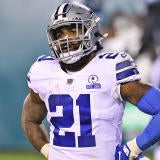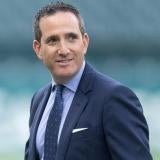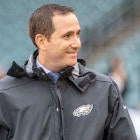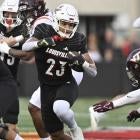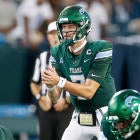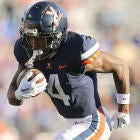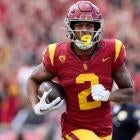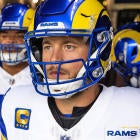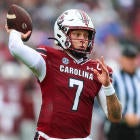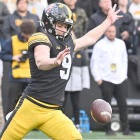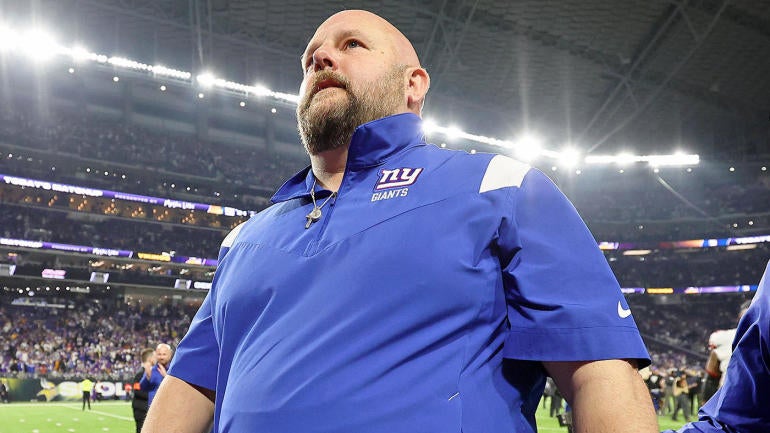
Last year, we broke down the value of the No. 1 overall draft pick in trade discussions and listed what it would cost each potentially interested team to move up with the Bears and get to the No. 1 pick. The last team on our list was the Panthers, and while the trade parameters we listed weren't followed exactly, by valuing D.J. Moore in a similar way to what other No. 1 receivers like A.J. Brown and Marquise Brown went for in recent draft-day trades, we were pretty spot on.
The early returns on the trade for the Panthers haven't been great -- they ended up giving up the first-overall pick this year after struggling to do anything on offense without Moore -- but that's not going to stop teams from exploring a trade up again this year with a class that could feature four quarterbacks selected in the top 10. Unlike last year, the Bears probably aren't selling the No. 1 pick, and it also seems unlikely the Commanders would move down from No. 2.
That means the trade fireworks could start at No. 3, where the Patriots are also in need of a franchise quarterback but may be willing to move down if their preferred second option (assuming Caleb Williams is first on everyone's boards and the pick at No. 1) is taken by Washington. Teams that would make sense in move up to draft a quarterback include the Giants, Vikings, Broncos and Raiders. If the Patriots do stand pat and take a QB, the last three teams on that list could be in play to trade ahead of the Giants for the last of the top-four QBs.
In this space, we're going to examine what it would take for the Giants to trade up to No. 3, 4 or 5 using my draft pick value chart. I developed the chart years ago when I was the NFL Draft editor at CBS Sports and have maintained it ever since so that our team could continue to use it to put together realistic trades based on how teams have valued draft picks in recent years. The way the chart works is that a team that wants to trade up typically needs to beat the listed value of a pick for a trade to happen, though there are always a few cases where the team moving down takes slightly less.
Last year, the first picks-only trade happened at No. 3, where the Texans gave 667.73 points of value for a pick valued at 658.52 points (after subtracting the value of the extra pick included by the Cardinals). But the context of the draft also matters, as that trade was for pass rusher Will Anderson Jr. rather than a QB. Two years prior, the 49ers surrendered 704.47 points of value to make the same move from 3 to 12 for a quarterback without knowing which would be available. And in 2018, the Jets surrendered 803.92 points of value (more than our current valuation of the No. 2 overall pick) to get from 6 to 3, also without knowing who would be available but in a QB class that was generally considered one of the best of all-time in the moment.
The 2024 quarterback class is more in line with 2021 than 2018 on the surface, with one standout at the top and then questions about the order thereafter (Zach Wilson, Justin Fields, Trey Lance or Mac Jones in 2021; Drake Maye, Jayden Daniels and J.J. McCarthy this year). That means the Patriots should expect to get anywhere from the 658.52 points of value we've set as the baseline for the No. 3 pick to 50 points more to reflect the 49ers deal from 2021 if they are to move down, and potentially more if there's a competitive market for the pick like we assume there was in 2018.
Below, we're going to cover what it would take for the Giants to move up with the Patriots in a draft pick trade in the three different scenarios for trading the pick (baseline value, medium value, competitive-market value). Then we'll hit the price for moving up to No. 4 or No. 5 in the scenario where the Patriots keep the pick, or someone else outbids the Giants for No. 3 and they want to protect themselves from another trade up for the fourth QB on the board.
For more draft coverage, you can hear in-depth analysis twice a week on "With the First Pick" -- our year-round NFL Draft podcast with NFL Draft analyst Ryan Wilson and former Vikings general manager Rick Spielman. You can find "With the First Pick" wherever you get your podcasts: Apple Podcasts, Spotify, YouTube, etc. Listen to the latest episode below!
Trading to No. 3: Baseline value
- Giants receive No. 3 (658.52 points)
- Patriots receive No. 6, No. 47, 2025 second-round pick (664.71 points)
In these deals, we value future picks as the round of the pick times 32, so roughly as the last pick of the round in the current draft. But teams will have different values on these picks based on things like their overall strategy, the projected quality of the team tied to the pick in the relevant year, and so on. Essentially, if the Patriots believe the Giants will be really bad next year and that pick will end up in the 30s, or if they don't have as steep a penalty on future picks versus current picks, they might attach more value to it than we have.
This should be the minimum price for the Giants to move up from No. 6 to No. 3 -- anything less and the Patriots should hang up the phone, and if this is the final offer, there's every possibility New England still passes on the deal.
Trading to No. 3: Medium value
- Giants receive No. 3 (658.52 points)
- Patriots receive No. 6, No. 70, 2025 first-round pick (710.90 points)
Here we have a deal more in line with what it cost the 49ers to get to No. 3 in 2021 and eventually take Trey Lance. Trading next year's first-round pick to only move up three spots for the third-best QB in the draft may be a tough sell, but if the Patriots get on the clock and the player the Giants were targeting is still there, it's a price they'd have to consider. Ultimately, I don't think the Giants front office gives up their 2025 first in this type of deal, so let's look at an alternative ...
- Giants receive No. 3, No. 103 (686.57 points)
- Patriots receive No. 6, No. 47, No. 70, 2025 second-round pick (728.75 points)
This would be less net value for the Patriots than the 2025 first-round pick trade above, but it's only a few points short of the value added to the pick in the 49ers trade in 2021. There, the 49ers gave up about 46 more points of value than what we list as the value of the No. 3 pick. In this deal, the Patriots would receive about 42 more points of value.
This completely takes the Giants out of Day 2 of the 2024 draft, so it'd still be a tough pill to swallow. But if the team feels it needs a particular QB to reach the next level and it has the opportunity, it'll have to consider paying this price.
Trading to No. 3: Competitive market value
- Giants receive No. 3 (658.52 points)
- Patriots receive No. 6, No. 47, 2025 first-round pick (759.87 points)
This trade doesn't quite reach the deal the Jets made to move up from No. 6 to 3 for what ultimately ended up being Sam Darnold. That deal included three second-round picks in addition to No. 6, and had the Giants not sent No. 39 to the Panthers in the Brian Burns deal, they could've put together a similar offer if they wanted, one the Patriots would surely have taken in a heartbeat.
I believe the deal above would be enough for the Patriots to pass on drafting a QB at No. 3 even if one is available that they like. They could still have a chance at taking a QB at No. 6, and the two assets they're receiving in addition could go a long way toward helping to build the core of their future. I'll also note that the Patriots have been willing to take less in deals than my chart reflects, including doing so to move down from No. 14 to 17 in last year's draft. However, it's anyone's guess what their draft philosophy will be in a post-Bill Belichick world.
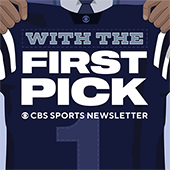
With The First Pick Newsletter
With The First Pick Newsletter
Prepare for the upcoming NFL Draft with the day’s big stories + mock drafts, big board updates and more.
Thanks for signing up!
Keep an eye on your inbox.
Sorry!
There was an error processing your subscription.
Trading to No. 4
- Giants receive No. 4 (577.65 points)
- Cardinals receive No. 6, No. 107, 2025 second-round pick (577.39 points)
We're not going to break down multiple scenarios for the Giants moving up to No. 4 or No. 5, but we'll focus on a realistic offer for the Cardinals or Chargers to take. In this scenario, quarterbacks have likely gone with the first three picks and the Giants are worried someone is trading ahead of them to take the fourth quarterback, assuming the guy who's left is someone New York actually wants.
If quarterbacks do go in the first three picks and the Giants are perceived to be coming up for a QB, the Cardinals should be interested in moving down, picking up extra assets and still walking away with either Marvin Harrison Jr. or Malik Nabers as their new No. 1 receiver. That would make the Giants a more attractive partner than a trade down to the teens with one of the other QB-needy teams.
Trading to No. 5
- Giants receive No. 5, No. 140, No. 225 (535.2 points)
- Chargers receive No. 6, No. 70 (541.38 points)
The Chargers typically aren't a team looking to trade picks, and the drop from No. 70 to 140 feels like too much to be acceptable on the Giants' side. I don't think this deal has a chance of happening unless the Giants are desperate and believe the Chargers have a deal in place to move down to the teens with a team looking for a QB. Even so, I'd say this is the least likely of our scenarios.
We'll cover those other teams who should be looking to move up for a quarterback in future content, so if you're a fan of the Vikings, Broncos and Raiders, or you're interested in knowing what the Patriots, Cardinals or Chargers should expect to move down further in the draft, be sure to keep an eye out for those articles.








